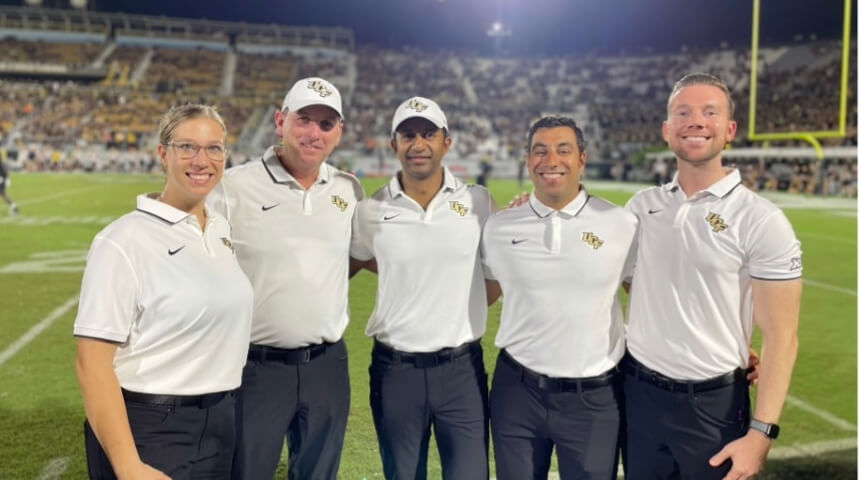Concussions on the Rise in High School Football—How We Can Protect Our Kids
Football—it’s an exciting, action-packed sport that many of our kids love watching, playing and talking about. They spend their weekends throwing the pigskin around the backyard and watching football on TV as they aspire to one day be as great as their favorite player. We support them at their high school football games and cheer loudly when they score a touchdown or make a last-minute tackle.
While football may be a popular and exciting sport, it can also be an aggressive and dangerous one. There’s plenty of contact, hard-hitting tackles and, yes, even serious injuries. One of these major injuries is concussions. For years, concussions caused by football tackles were ignored and largely written off as “no big deal.” But in recent years, doctors, coaches and researchers have learned just the opposite—they are a big deal and they most certainly should not be ignored.
Unfortunately, however, concussions are still an extremely prevalent issue at every level of the sport. After sustaining a concussion, many players—from the high school level all the way to the pros—will pretend like it’s “no big deal.” As soon as they “feel OK,” they’re eager to get that helmet back on and get back in the game. In some cases, players may not even tell a parent, coach or doctor that they’re experiencing symptoms of a concussion because they don’t want to be taken out of the game.
But the reality is, that’s just not safe for the short-term or long-term health of the athlete.
New Laws Limit Full-Contact Practice
Thankfully, major steps are being taken to protect middle school and high school athletes from concussions and other serious injuries. In July 2014, the California state legislature passed a law that restricts the amount of full-contact practice for middle and high school football players. The law states that these players can only participate in full-contact practice twice a week for 90 minutes each—a total of three hours per week. And that’s just during the preseason and regular season. During the offseason, full-contact practices aren’t allowed at all.The goal of this new law is to create more awareness about concussions, as well as other injuries, and try to limit them by restricting the amount of contact that players have over the course of a year. Now, you might be wondering, “This sounds great, but the law was passed in California. How does this affect my child?”
Well, for the time being, it doesn’t directly affect your child or the laws in our state. If your son plays football in the state of Florida, there is no restriction on the amount of full-contact practice he can participate in. In fact, some high school football players are getting hit in practice more often than professional athletes are.
But here’s the good news—this type of law is setting a precedent for other states across the country, including Florida. In fact, just a few years ago, the state of Texas passed a law similar to the one that was passed in California. It also restricts the amount of full-contact practice for high school and middle school football players.
And these rules don’t just stop at the high school level either. Interestingly enough, this type of restriction already exists at the professional level. In 2010, the National Football League put a policy in place that requires strict limitations on the amount of full-contact practice for its players.
Certain college football conferences, such as the Pac-12 and the Ivy League, have adopted these rules as well—all of which are designed to protect their players from suffering unnecessary concussions and other injuries.
So, while this law may not be nationwide for high school and middle school players right now, it’s certainly a very real possibility down the road, which would help make the game safer for thousands of young athletes.
How We Can Protect Our Kids from Concussions
Until these laws are passed nationwide, however, it is extremely important for parents, coaches, doctors and mentors to work together to make the game of football safer for our kids. In a sport that can often result in injury, it is our job to make sure that we try to prevent injury as much as we can.So, how can we do that? Well, first and foremost, it’s important that we make the decision to limit full-contact practices on our own, despite the fact that there’s no law in place. By exposing young athletes to full-contact practice every day, we’re putting them at risk for serious injury, including broken bones, ligament injuries and concussions. Without these restrictions, a football player can suffer cumulative impacts that will wear on the athlete over the course of the season and the school year—which may hurt production both on the field and in the classroom.
The second thing we can do is teach proper tackling techniques without actually tackling. Now, this may seem contradictory, but it’s true. It’s necessary to teach blocking and tackling techniques—but within certain limitations. And education of those techniques can happen without necessarily needing to have contact with another athlete.
It’s also important to realize that limiting contact does not necessarily make a player more likely to get injured during a game. While some may argue that this is true, there is actually no evidence or data that supports this claim. Whether they tackle in practice once a week or five times a week, players always face the same risk of injury once they enter the game.
Finally, we have to remember that the game of football is just that—a game. And at the end of the day, we’re playing this game for fun. Sure, it’s OK to be competitive on the field, but we don’t want to play with the intention of causing injury. We have to play competitively but play safe as well.
Although we still have a long way to go in protecting our kids from concussions and other serious injuries, we have come a long way as well. And this new law is just another step in the right direction.
To learn more about the signs of a concussion, visit the STOP Sports Injuries website.










